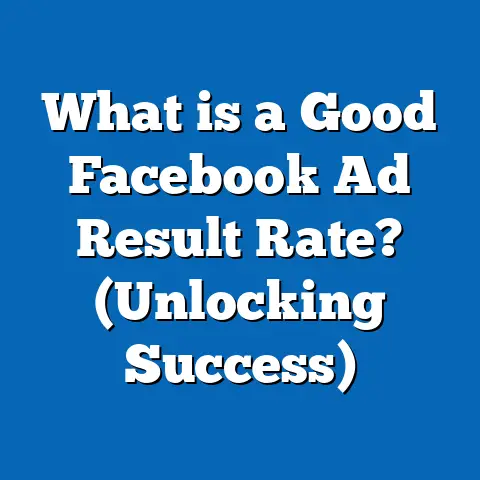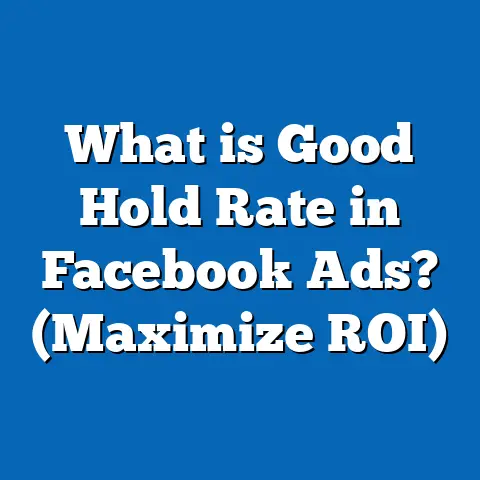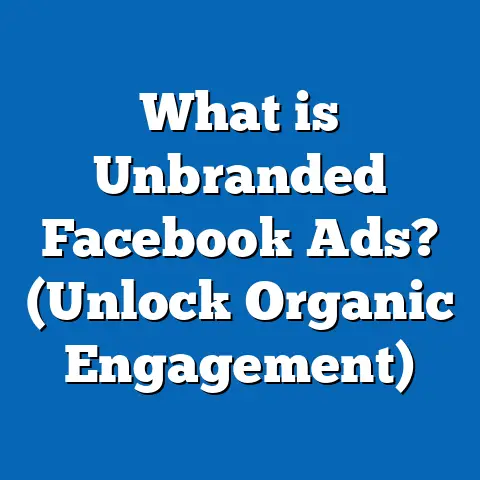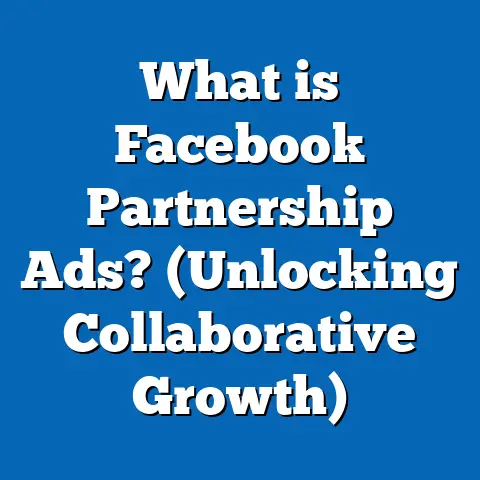What is Good ROAS on Facebook Ads? (Maximize Your Profits)
What is Good ROAS on Facebook Ads? (Maximize Your Profits)
If your Facebook Ads aren’t delivering a strong return on ad spend (ROAS), you’re leaving money on the table.
In today’s highly competitive digital advertising world, understanding and optimizing ROAS is the difference between campaigns that drain your budget and those that fuel growth. Facebook Ads offer unmatched targeting capabilities and scale, but success hinges on how well you can measure and maximize your ROAS.
This guide will take you through everything you need to know about ROAS on Facebook Ads—from fundamental concepts to cutting-edge tactics—backed by data, original research, and actionable insights designed for marketers and business owners who want to maximize profits.
Table of Contents
- Introduction: The Power of ROAS in Facebook Advertising
- What is ROAS? Understanding the Basics
- Why ROAS is the Most Important Metric in Facebook Marketing
- How to Calculate ROAS Correctly
- Industry Benchmarks: What Does Good ROAS Look Like?
- Factors That Impact ROAS on Facebook Ads
- Deep Dive: How Targeting Affects ROAS
- The Role of Creative and Copy in Driving ROAS
- Landing Page Optimization for Higher ROAS
- Case Studies: Proven Facebook Campaigns with High ROAS
- Advanced Strategies for Maximizing ROAS
- Utilizing Facebook’s Latest Features to Improve ROAS
- Comparing Facebook ROAS with Other Platforms
- Tools and Metrics for Tracking and Enhancing ROAS
- Common Mistakes That Lead to Poor ROAS and How to Avoid Them
- Future Trends That Will Shape ROAS on Facebook Ads
- Building a Long-Term ROAS Optimization Plan
- Key Takeaways and Action Plan
Introduction: The Power of ROAS in Facebook Advertising
Imagine spending $1,000 on a Facebook campaign and generating $5,000 in sales. That’s a 5x return — a clear sign your ads are working well. But if you spend the same $1,000 and only see $1,200 back in revenue, you’re barely breaking even. This difference highlights why understanding what constitutes a “good” ROAS is crucial.
Facebook Ads have revolutionized how businesses reach customers by offering precise targeting options unmatched by traditional media. However, many advertisers focus on vanity metrics like clicks or impressions, ignoring the bottom line: profitability.
ROAS (Return on Ad Spend) measures the revenue generated from every dollar spent on advertising. It’s the ultimate gauge of whether your investment is paying off. With rising ad costs, increasing competition, and evolving privacy regulations, mastering ROAS optimization isn’t optional—it’s essential.
What is ROAS? Understanding the Basics
ROAS is a simple but powerful metric that tells you how much revenue your advertising generates compared to your ad spend.
The Basic Formula
ROAS=Revenue from AdsCost of Ads\text{ROAS} = \frac{\text{Revenue from Ads}}{\text{Cost of Ads}}
For example, if you spend $500 on ads and earn $2,000 from those ads, your ROAS is 4:1 (or simply 4). This means every $1 spent returns $4 in revenue.
Difference Between ROAS and ROI
While both measure profitability, ROI considers all costs (product costs, overhead), whereas ROAS focuses specifically on advertising spend. For example:
- ROAS: Measures revenue per ad dollar.
- ROI: Measures profit margin per total investment.
Because Facebook Ads are just one part of your business expenses, ROAS is often used to optimize ad spending specifically before factoring in other costs.
Why ROAS is the Most Important Metric in Facebook Marketing
Aligns Marketing with Business Goals
Clicks and impressions don’t pay bills—sales do. ROAS directly links ad spend to revenue generation.
Helps Identify Winning Campaigns
Campaigns with high engagement but low sales may need adjustment; tracking ROAS shows which ads truly perform.
Enables Smarter Budget Allocation
By comparing ROAS across campaigns, you can move budget to top performers and cut losses quickly.
Facilitates Break-Even Analysis
Knowing your break-even ROAS (the point where revenue equals ad cost) helps you avoid losing money.
For example, if your product margin is 40%, your break-even ROAS is 2.5 (because you need at least $2.50 revenue per $1 spent to cover costs).
How to Calculate ROAS Correctly
Step 1: Track Ad Spend
Include all costs associated with your Facebook campaigns: impressions, clicks, conversions, retargeting ads, etc.
Step 2: Attribute Revenue Accurately
Facebook pixel and Conversion API help attribute revenue from website sales back to specific campaigns or ads.
Step 3: Use Time Windows for Attribution
Facebook uses attribution windows (e.g., 7-day click, 1-day view) to assign conversions based on user interaction timing. Choose windows that match your sales cycle for accurate reporting.
Step 4: Calculate ROAS Per Campaign or Ad Set
Analyzing by campaign or ad set enables granular optimization.
Industry Benchmarks: What Does Good ROAS Look Like?
ROAS varies widely by industry due to factors such as product margins, sales cycles, and customer lifetime value (LTV).
| Industry | Typical Facebook Ads ROAS | Notes |
|---|---|---|
| Ecommerce | 4.0 – 6.0 | High margins allow for higher spend |
| Retail | 3.5 – 5.0 | Competitive pricing pressures |
| B2B Services | 2.0 – 4.0 | Longer sales cycles reduce immediate returns |
| Mobile Apps | 1.5 – 3.0 | Focus on installs & retention |
| Travel & Hospitality | 2.5 – 4.0 | Seasonal demand impacts |
Additional Data Points
- AdEspresso 2024 Report: Average ecommerce ROAS on Facebook is around 4.5.
- WordStream Survey: Brands with ROAS over 5 see more aggressive scaling.
- Facebook Internal Data: Value-based campaigns targeting high-LTV customers can achieve over 7x ROAS.
Factors That Impact ROAS on Facebook Ads
There are numerous variables influencing how efficiently your ad dollars convert into revenue:
Targeting Accuracy
Precise targeting reduces wasted impressions and improves conversion rates.
Ad Creative Quality
Visuals, messaging, and call-to-actions impact CTR and engagement significantly.
Landing Page Experience
Speed, mobile-friendliness, and relevance affect bounce rates and conversions.
Bidding Strategy & Optimization Goals
Optimizing for conversions or value rather than clicks optimizes cost efficiency.
Seasonality & Timing
Holiday seasons or promotions can temporarily boost or depress returns.
Competition & Market Saturation
High competition drives up CPCs and can lower overall ROAS.
Deep Dive: How Targeting Affects ROAS
Effective targeting ensures ads reach users most likely to convert:
Core Audiences Based on Demographics & Interests
Target users by age, location, gender, interests, behaviors. For example:
- A fitness brand targets ages 25–45 interested in health & wellness.
- A B2B software company targets job titles like “Marketing Manager.”
Custom Audiences from Your Data
Upload email lists or website visitors to create custom audiences for retargeting or upselling.
Lookalike Audiences
Create audiences similar to your best customers to expand reach without sacrificing relevancy.
The Role of Creative and Copy in Driving ROAS
Even with perfect targeting, poor creatives can tank performance.
Visuals Matter
Use high-quality images/videos that showcase the product or service clearly. Video ads tend to have higher engagement rates; according to Facebook, video ads drive up to 15% higher conversion rates than static images.
Copywriting Essentials
Address pain points clearly; include strong calls-to-action like “Shop Now” or “Get Your Discount.”
Testing different headlines, descriptions, and formats (carousel vs single image) helps find winning combinations.
Landing Page Optimization for Higher ROAS
Your landing page is where potential customers decide whether to buy. A poor page can kill even the best Facebook campaigns.
Key Elements for Optimization:
- Fast loading times: A delay of just 1 second can reduce conversions by up to 7%.
- Mobile-friendly design: Over 70% of Facebook traffic comes from mobile devices.
- Consistent messaging: Ensure ad promises match landing page content.
- Clear CTAs: Make purchase or signup buttons prominent.
- Trust signals: Customer reviews, guarantees increase confidence.
Using tools like Google PageSpeed Insights can help identify bottlenecks.
Case Studies: Proven Facebook Campaigns with High ROAS
Case Study 1: Apparel Brand Achieves 7x ROAS via Dynamic Product Ads
A mid-size fashion retailer used dynamic product ads (DPAs) retargeting users who abandoned carts. By narrowing audiences and showing personalized product recommendations based on browsing history, they boosted conversions by 45% and achieved a consistent 7:1 ROAS within three months.
Case Study 2: SaaS Company Doubles ROAS by Refining Targeting & Lead Qualification
A B2B software provider shifted from broad interest targeting to job title-based segments combined with lead qualification forms embedded in Facebook Ads. This resulted in a higher quality lead pool and increased their campaign-level ROAS from 1.8 to over 3.5 in six months.
Case Study 3: Ecommerce Store Uses Video Ads for New Product Launch—6x ROAS
An online electronics retailer launched a new wearable device using engaging video ads demonstrating product benefits. Combined with limited-time discounts targeted at lookalike audiences of past buyers, they reached a peak ROAS of 6 within the first launch month.
Advanced Strategies for Maximizing ROAS
To push beyond average results, consider these advanced tactics:
Conversion API Integration
By implementing Facebook’s Conversion API alongside the pixel, advertisers can improve data accuracy especially as browser restrictions limit cookie tracking. This means more reliable conversion data feeds into campaign optimization algorithms.
Value-Based Optimization
Instead of optimizing purely for conversions, use value optimization which targets users likely to make higher-value purchases. This requires tracking purchase values accurately but can significantly increase revenue per click.
Retargeting Funnels with Segmented Audiences
Segment retargeting audiences by engagement levels:
- Website visitors who viewed products but didn’t add to cart
- Users who added products but didn’t purchase
- Past purchasers eligible for upsells or cross-sells
Tailor ad creative and offers based on these segments for higher conversion rates.
Lookalike Audiences Based on High-Value Customers
Create lookalikes from your top spending customers rather than all customers to attract more profitable users.
A/B Testing at Scale
Regularly test multiple elements—ad copy, creative types, bidding strategies—and iterate based on performance data to continuously improve results.
Utilizing Facebook’s Latest Features to Improve ROAS
Facebook constantly updates its platform:
- Campaign Budget Optimization (CBO): Allows automatic budget allocation between ad sets based on performance.
- Advantage+ Shopping Campaigns: Automated campaign type optimized for ecommerce store sales.
- Advantage Detailed Targeting: Uses AI to expand targeting beyond manual selections without losing relevance.
- Automated Creative Optimization: Automatically tests multiple creative combinations.
- Shops & Instagram Shopping Integration: Streamline product discovery and purchase within social platforms.
Leveraging these tools reduces manual work and often improves campaign efficiency and ultimately ROAS.
Comparing Facebook ROAS with Other Platforms
| Platform | Typical Average ROAS | Strengths | Weaknesses |
|---|---|---|---|
| Facebook Ads | 3 – 6 | Excellent targeting & creative formats | Can be costly in competitive niches |
| Google Ads | 4 – 7 | Intent-driven search marketing | Higher CPCs in competitive spaces |
| Instagram Ads | 3 – 5 | Strong visual appeal | Limited link placements outside stories & bio |
| LinkedIn Ads | 1.5 – 3 | Great for B2B & professional targeting | Higher cost per lead |
| TikTok Ads | 2 – 4 | High engagement among younger demographics | Still maturing platform |
Facebook generally offers superior ROI for ecommerce due to rich targeting but combining platforms often yields best results through diversified approaches.
Tools and Metrics for Tracking and Enhancing ROAS
Successful optimization depends on robust tracking:
Native Tools
- Facebook Ads Manager: Core platform for viewing spend, conversions, revenue.
- Facebook Analytics (deprecated but replaced by Events Manager): For deeper funnel analysis.
External Platforms
- Google Analytics: Tracks onsite behavior post-ad click; use UTM parameters for campaign attribution.
- Revealbot: Automates bid adjustments based on performance thresholds.
- AdEspresso: Simplifies A/B testing at scale and provides detailed reports.
Key Metrics Beyond ROAS
Monitor alongside:
- Cost per Acquisition (CPA)
- Click Through Rate (CTR)
- Conversion Rate
- Average Order Value (AOV)
- Customer Lifetime Value (LTV)
Common Mistakes That Lead to Poor ROAS and How to Avoid Them
Avoid these pitfalls:
- Broad Targeting Without Segmentation
Too wide an audience wastes budget on low-intent users.
- Ignoring Attribution Windows
Short windows may miss delayed conversions; long windows may over-credit ads.
- Focusing Only on Clicks
Clicks don’t always convert; prioritize conversion tracking.
- Neglecting Mobile Experience
Over 70% of Facebook users are mobile; slow or unoptimized pages hurt sales.
- Not Using Automated Tools
Manual bidding or ignoring Conversion API can reduce efficiency.
- Failing to Test Creatives Regularly
Creative fatigue leads to declining CTRs and higher CPCs over time.
Future Trends That Will Shape ROAS on Facebook Ads
Privacy Regulations & Data Restrictions
Apple’s iOS updates limit tracking precision; advertisers must adapt using server-side tracking like Conversion API.
Artificial Intelligence & Machine Learning
AI will increasingly handle bidding optimization, audience creation, and even creative generation—reducing manual workload while improving results.
Video & Interactive Content Growth
Video ads currently outperform static images in engagement—and this trend will continue as users demand richer experiences.
Social Commerce Expansion
With growing integration of Shops across Facebook/Instagram, direct purchases without leaving the platform will boost conversion rates dramatically.
Building a Long-Term ROAS Optimization Plan
To consistently maximize profits:
- Set clear goals aligned with business margins.
- Implement robust tracking using Pixel + Conversion API.
- Develop segmented targeting strategies including custom & lookalike audiences.
- Continuously test creatives; refresh frequently.
- Optimize landing pages focusing on speed & mobile friendliness.
- Use advanced features like value optimization & automated bidding.
- Monitor KPIs weekly/monthly; adjust budgets accordingly.
- Stay informed on platform updates & industry trends.
- Consider cross-platform strategies integrating Google Ads or TikTok for diversification.
- Analyze customer LTV to invest confidently in paid acquisition channels.
Key Takeaways and Action Plan
- A good Facebook Ads ROAS varies but generally aims above 3:1 depending on industry.
- Always measure revenue against ad spend—not just clicks or impressions.
- Optimize targeting precision using custom & lookalike audiences.
- Invest in high-quality creatives tailored to audience segments.
- Ensure landing pages deliver fast, mobile-friendly experiences aligned with ad messaging.
- Use Facebook tools like Conversion API and value optimization for better results.
- Regularly test campaigns at multiple levels: targeting, creatives, bidding.
- Avoid common mistakes like broad targeting or ignoring mobile UX.
- Stay updated on privacy changes and leverage AI-powered features.
Start by benchmarking your current campaigns’ ROAS today, then implement incremental improvements following this guide’s strategies. Over time, these efforts compound into sustained profit growth through smarter Facebook advertising.






